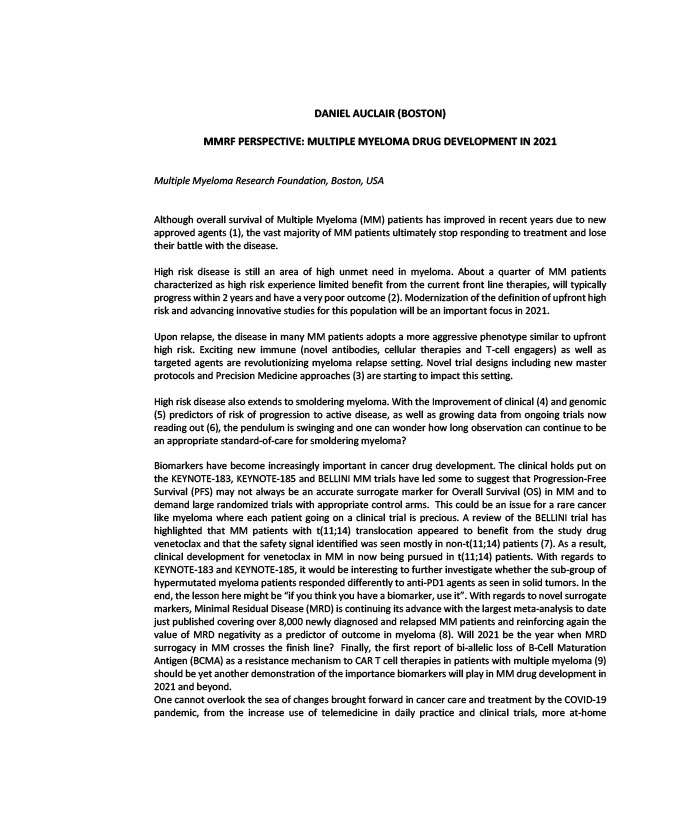
DANIEL AUCLAIR (BOSTON)
MMRF PERSPECTIVE: MULTIPLE MYELOMA DRUG DEVELOPMENT IN 2021
Multiple Myeloma Research Foundation, Boston, USA
Although overall survival of Multiple Myeloma (MM) patients has improved in recent years due to new
approved agents (1), the vast majority of MM patients ultimately stop responding to treatment and lose
their battle with the disease.
High risk disease is still an area of high unmet need in myeloma. About a quarter of MM patients
characterized as high risk experience limited benefit from the current front line therapies, will typically
progress within 2 years and have a very poor outcome (2). Modernization of the definition of upfront high
risk and advancing innovative studies for this population will be an important focus in 2021.
Upon relapse, the disease in many MM patients adopts a more aggressive phenotype similar to upfront
high risk. Exciting new immune (novel antibodies, cellular therapies and T-cell engagers) as well as
targeted agents are revolutionizing myeloma relapse setting. Novel trial designs including new master
protocols and Precision Medicine approaches (3) are starting to impact this setting.
High risk disease also extends to smoldering myeloma. With the Improvement of clinical (4) and genomic
(5) predictors of risk of progression to active disease, as well as growing data from ongoing trials now
reading out (6), the pendulum is swinging and one can wonder how long observation can continue to be
an appropriate standard-of-care for smoldering myeloma?
Biomarkers have become increasingly important in cancer drug development. The clinical holds put on
the KEYNOTE-183, KEYNOTE-185 and BELLINI MM trials have led some to suggest that Progression-Free
Survival (PFS) may not always be an accurate surrogate marker for Overall Survival (OS) in MM and to
demand large randomized trials with appropriate control arms. This could be an issue for a rare cancer
like myeloma where each patient going on a clinical trial is precious. A review of the BELLINI trial has
highlighted that MM patients with t(11;14) translocation appeared to benefit from the study drug
venetoclax and that the safety signal identified was seen mostly in non-t(11;14) patients (7). As a result,
clinical development for venetoclax in MM in now being pursued in t(11;14) patients. With regards to
KEYNOTE-183 and KEYNOTE-185, it would be interesting to further investigate whether the sub-group of
hypermutated myeloma patients responded differently to anti-PD1 agents as seen in solid tumors. In the
end, the lesson here might be “if you think you have a biomarker, use it”. With regards to novel surrogate
markers, Minimal Residual Disease (MRD) is continuing its advance with the largest meta-analysis to date
just published covering over 8,000 newly diagnosed and relapsed MM patients and reinforcing again the
value of MRD negativity as a predictor of outcome in myeloma (8). Will 2021 be the year when MRD
surrogacy in MM crosses the finish line? Finally, the first report of bi-allelic loss of B-Cell Maturation
Antigen (BCMA) as a resistance mechanism to CAR T cell therapies in patients with multiple myeloma (9)
should be yet another demonstration of the importance biomarkers will play in MM drug development in
2021 and beyond.
One cannot overlook the sea of changes brought forward in cancer care and treatment by the COVID-19
pandemic, from the increase use of telemedicine in daily practice and clinical trials, more at-home